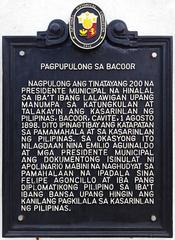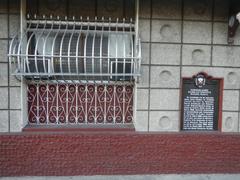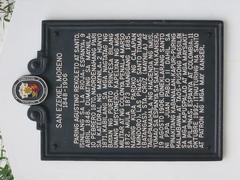
Zapote Bridge Visiting Guide: Bacoor, Philippines – History, Tickets, and Visitor Tips
Date: 04/07/2025
Introduction: Zapote Bridge’s History and Significance
Zapote Bridge, found at the boundary of Bacoor, Cavite, and Las Piñas, Metro Manila, stands as a powerful symbol of Filipino resilience and patriotism. More than a vital crossing over the Zapote River, this bridge is etched into the nation’s collective memory as the site of pivotal battles during both the Philippine Revolution and the Philippine–American War. These historic events have elevated Zapote Bridge to a National Historical Landmark, embodying the Filipino spirit of courage and the ongoing quest for independence (National Historical Commission of the Philippines; Wikipedia: Battle of Zapote Bridge (1897)).
Strategically located just 15 kilometers southwest of Manila, Zapote Bridge is easily accessible via the General Emilio Aguinaldo Highway and Manila-Cavite Expressway (CAVITEX). With no entrance fee, wheelchair-accessible pathways, and nearby parking, it welcomes all visitors. The bridge is also closely integrated with Bacoor’s vibrant cultural scene, featuring nearby museums, commemorative monuments, and annual historical reenactments.
This comprehensive guide covers Zapote Bridge’s historical background, cultural significance, practical visitor information, travel tips, and nearby attractions, ensuring you have all the details needed for a meaningful visit (Trip the Islands; Flybreak; Vigattin Tourism).
Contents
- Introduction
- History and Significance
- Early Context
- The Philippine Revolution and the Cavite Offensive
- The Battle of Zapote Bridge
- Aftermath and Continuing Struggle
- The Philippine–American War Era
- Cultural and National Importance
- Heritage Designation
- Role in Identity and Education
- Commemorative Monuments
- Influence on Art and Literature
- Pilgrimage and Civic Events
- Local Tourism and Economic Impact
- Visiting Zapote Bridge: Practical Guide
- Hours and Admission
- Accessibility and Facilities
- Travel Tips
- Transportation and Navigation
- Nearby Attractions and Modern Bacoor
- Historical Sites and Urban Growth
- Conservation Initiatives
- Infrastructure Developments
- Visitor Experience
- Tours and Photography
- Cultural Events
- Frequently Asked Questions
- Summary and Final Tips
- Sources
Discover Zapote Bridge: A Historic Landmark and Travel Destination
Zapote Bridge is more than a crossing—it’s a living monument. As one of the most significant historical sites in Cavite, it draws history enthusiasts and casual visitors alike. The bridge’s location, connecting Cavite and Metro Manila, makes it an accessible and educational destination.
Visiting Hours, Admission, and Accessibility
- Hours: Open daily from 6:00 AM to 8:00 PM.
- Admission: Free for all visitors.
- Accessibility: Wheelchair-accessible paths and nearby parking.
- Best Time to Visit: The dry season (November to May), with early mornings ideal for photography and fewer crowds.
Historical Background: The Battles at Zapote Bridge
Early Historical Context
Zapote Bridge’s strategic position made it a coveted military objective, linking Cavite and Manila for both commerce and military maneuvers (Trip the Islands).
The Philippine Revolution and the Cavite Offensive
In 1896, Cavite became a stronghold for the Katipunan. The Spanish, led by Governor-General Camilo de Polavieja, launched the Cavite Offensive to reclaim the province. The Filipino revolutionaries, under General Emilio Aguinaldo, prepared to defend Zapote Bridge against a massive Spanish assault (Wikipedia: Battle of Zapote Bridge (1897)).
The Battle of Zapote Bridge (February 17, 1897)
Filipino forces, numbering around 10,000, set dynamite charges on the bridge and bamboo stakes in the riverbed. When Spanish troops attempted to cross, the explosives detonated, resulting in chaos and heavy casualties. The battle saw intense hand-to-hand combat and the loss of General Edilberto Evangelista, a key Filipino leader (Wikipedia: Battle of Zapote Bridge (1897)).
Despite being outnumbered and outgunned, the Filipino revolutionaries inflicted significant losses on the Spanish, forcing them to retreat.
Aftermath and Continuing Struggle
The revolutionaries’ victory was short-lived as Spanish forces soon renewed their offensive, leading to additional battles in the region.
Zapote Bridge During the Philippine–American War
In 1899, Zapote Bridge again became a battlefield, this time against American forces, further cementing its status as a symbol of national resistance (Flybreak).
Cultural and National Significance
Heritage Designation and Preservation
Zapote Bridge was declared a National Historical Landmark in 2013 by the National Historical Commission of the Philippines (NHCP), ensuring its protection and ongoing restoration (NHCP; NHCP Restoration Projects).
Role in Identity and Education
Zapote Bridge is a point of pride for Bacoor and Las Piñas residents. It hosts annual reenactments and educational tours, and is featured in textbooks and school programs, fostering patriotism (Bacoor City Government; DepEd Cavite).
Commemorative Monuments and Markers
Monuments and plaques at both ends of the bridge honor key figures such as General Emilio Aguinaldo and General Edilberto Evangelista, and commemorate the sacrifices made during the battles (NHCP Markers).
Influence on Art and Literature
Zapote Bridge has been immortalized in paintings, literature, and poetry, serving as a muse for Filipino artists and writers (Cultural Center of the Philippines).
Pilgrimage and Civic Events
Veterans’ groups, descendants of revolutionaries, and community organizations gather at the bridge for memorial ceremonies, especially on February 17th (Philippine Veterans Affairs Office).
Local Tourism and Economic Impact
The bridge attracts tourists, benefiting local businesses and supporting cultural tourism initiatives (Department of Tourism). Enhancements like interpretive signage and digital heritage trails enrich the visitor experience.
Visiting Zapote Bridge: Practical Guide
Getting There: Location and Transport
Zapote Bridge is accessible via the Aguinaldo Highway, CAVITEX, and the Cavite-Laguna Expressway (CALAX). Jeepneys, buses, and UV Express vans service the route (Vigattin Tourism; Pinnacle Homes). For last-mile connectivity, tricycles and taxis are available.
On-Site Navigation
- Pedestrian Access: The original stone bridge is preserved for pedestrians, while a modern bridge runs parallel for vehicles (Wikipedia).
- Monuments: Key monuments include the General Evangelista statue (Bacoor side) and the Three Women Monument (Las Piñas side) (Camella; Hands-On Parent While Earning).
- Riverwalk: The Zapote River Walk and Bike Lane offers murals and a scenic park (Bacoor City Government).
Facilities and Amenities
- Parking: Limited spaces available near the original bridge, especially on the Bacoor side.
- Restrooms: Not available at the site; nearest facilities are in nearby malls like SM City Bacoor.
- Shops and Eateries: Local markets and restaurants in Las Piñas offer authentic Filipino cuisine (Tourist Places Guide).
Practical Tips
- Weather: Visit during the dry season (November–April) for optimal weather.
- Crowds: Early mornings and late afternoons are less crowded and offer better light for photography.
- Safety: Stay alert near busy roads; use pedestrian walkways.
Nearby Attractions and Modern Bacoor
Historical Sites and Urban Growth
Bacoor is home to other notable sites such as St. Michael the Archangel Parish and the Aguinaldo Shrine. Urban development has brought affordable housing, retail centers, and improved infrastructure (Trek Zone; Pinnacle Homes).
Conservation and Environment
The restored pedestrian promenade and monument parks honor the bridge’s history, while the Bacoor Mangroves offer eco-tourism and conservation opportunities (Hop N Cruise).
Infrastructure Developments
Projects like the Bataan-Cavite Interlink Bridge and Sangley Point International Airport will further enhance Bacoor’s accessibility and tourism potential (Richest PH).
Visitor Experience: Tours, Events, and Photography
- Tours: Self-guided visits are common, with occasional guided tours arranged by local groups or through the NHCP, especially during commemorative events.
- Photography: Best in early morning or late afternoon; highlight the original bridge, riverwalk murals, and monuments.
- Cultural Events: Annual reenactments and ceremonies occur every February 17th, with wreath-laying and historical presentations (Trip the Islands).
Frequently Asked Questions (FAQ)
Q: What are the visiting hours?
A: Open daily from 6:00 AM to 8:00 PM.
Q: Is there an entrance fee?
A: No, admission is free.
Q: Are guided tours available?
A: Occasionally, especially during commemorative events. Check with local tourism offices or the NHCP.
Q: Is the site wheelchair accessible?
A: Yes, but some uneven surfaces may require assistance.
Q: Where can I park?
A: Limited parking is available near the Bacoor side; consider parking after the Zapote-Las Piñas interchange.
Q: What other sites can I visit nearby?
A: Aguinaldo Shrine, St. Michael the Archangel Parish, St. Joseph Parish Church, and the Bacoor Mangroves.
Summary and Final Tips
Zapote Bridge is a living testament to the Filipino spirit and the nation’s fight for independence. As a meticulously preserved National Historical Landmark, it offers a meaningful journey through history, complete with commemorative monuments and annual events. The bridge’s integration with Bacoor’s urban amenities, accessible transport options, and ongoing conservation efforts make it an ideal destination for travelers and history enthusiasts alike (National Historical Commission of the Philippines; Bacoor City Government; Villar Foundation).
Travel Tips:
- Visit during the dry season for the best weather.
- Arrive early to enjoy the site with fewer crowds.
- Use the Audiala app for audio guides and updates.
- Explore nearby cultural and natural attractions to enrich your experience.
Sources and Further Reading
- National Historical Commission of the Philippines
- Wikipedia: Battle of Zapote Bridge (1897)
- Trip the Islands
- Flybreak
- Vigattin Tourism
- Bacoor City Government
- Villar Foundation






